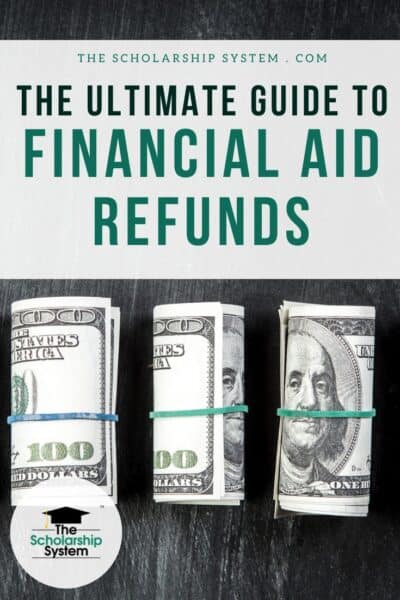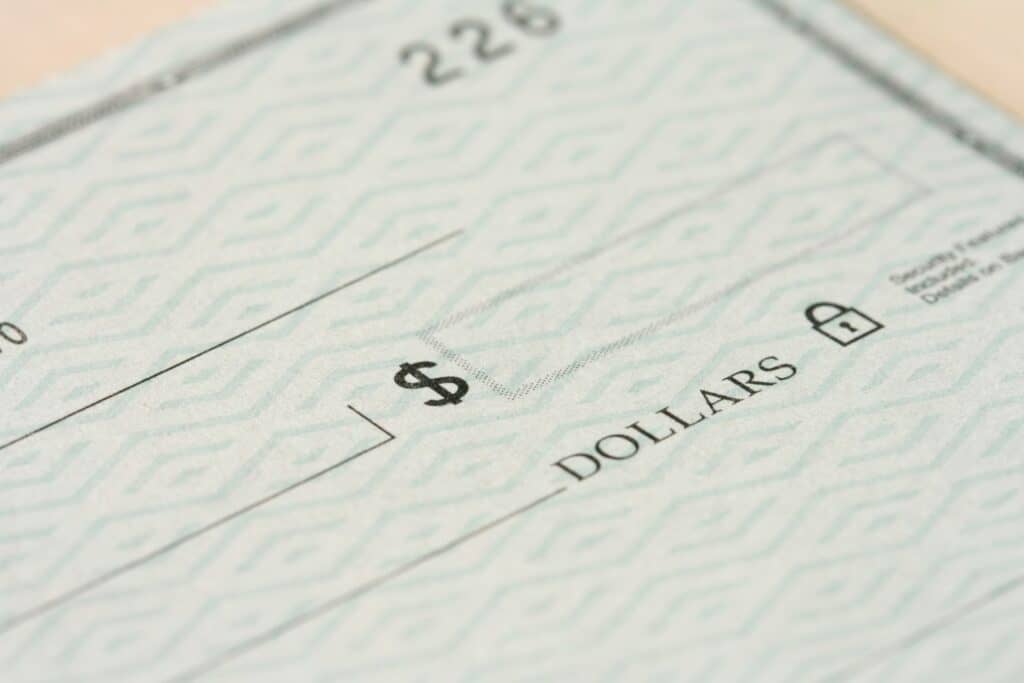Updated on July 5th, 2024
Navigating the complexities of financial aid can be daunting for both students and parents. Understanding financial aid refunds is crucial for making the most of available resources. In this guide, we will unravel the mysteries of refunded financial aid, provide essential definitions, and help you determine your eligibility. Stay tuned to learn everything you need to know about getting money back from financial aid funds.
If you and your student want to learn more about exciting scholarship opportunities, sign up for our free college scholarship webinar! Just head to http://thescholarshipsystem.com/freewebinar and reserve your spot today.
Understanding Financial Aid Refunds
Financial aid refunds play a vital role in managing educational expenses. When students receive more aid than necessary for the cost of their education, the surplus can be used for other costs like textbooks and living expenses. Understanding how these refunds work and impact a student’s budget is essential. By grasping these concepts, students can better plan and manage their finances.
What Is a Financial Aid Refund?
A financial aid refund occurs when the total amount of financial aid exceeds the cost of tuition, fees, and other direct educational expenses. This excess amount is refunded to the student to cover additional costs such as books, supplies, and personal expenses. It is crucial to manage these funds wisely to ensure they support educational goals and needs.
How Do I Check If I’m Eligible for a Refund?
Figuring out a student’s financial aid refund eligibility is reasonably straightforward. To check if your student is eligible for a refund, begin by reviewing their financial aid award letter and tuition bill. Compare the total amount of student aid received with the cost of tuition and fees. If there is a surplus, your student may be eligible for a refund. For specific questions, contact your school’s financial aid office to verify eligibility and understand the refund process.
Receiving Your Financial Aid Refund
Financial aid refund methods vary by institution. Most schools offer options such as a refund check, direct deposit into a bank account, or a prepaid debit card, allowing you to select your refund preference. To choose the best method, consider convenience and speed. Direct deposit often provides the quickest access to funds. Contact the financial aid office to set up your preferred financial aid refund payout method.
When Will I Receive My Financial Aid Refund?
The timing of a financial aid refund disbursement depends on the school’s schedule. Typically, schools disburse refunds after verifying that tuition and fees have been paid, with the loan servicer confirming the receipt of loan funds. This process can take a few weeks after the start of the semester. Check with the school’s financial aid office to get specific dates and ensure your student account credit is accurately processed.
How Will I Receive My Financial Aid Refund?
Once your student is eligible for a refund, understanding the process for receiving these funds is crucial. Schools have specific procedures for disbursing refunds, which can vary by institution. Knowing these steps will ensure that your student receives their financial aid refund smoothly and efficiently, allowing them to cover essential expenses without delay.
Using Your Financial Aid Refund Wisely
Getting financial aid refund money can be a significant relief for students and parents. However, it’s essential to use this extra money thoughtfully. Properly managing the financial aid refund check can help cover various necessary expenses and contribute to long-term financial health. Let’s explore the best ways to use your refund to ensure it supports educational and personal goals effectively.
Using Your Financial Aid Refund – The Essentials
Housing
Using part of the refund for housing is a smart move. Whether your student lives on or off campus, allocating money to cover rent or dorm fees ensures they have a stable and secure living environment. This planning helps avoid any housing-related stress throughout the semester, allowing them to focus on their studies.
Books
Textbooks can be a significant expense each semester. Setting aside a portion of the refund to purchase the required books is essential. By doing so, your student ensures they have all the necessary materials to succeed in their courses without the last-minute scramble for funds or borrowing from friends.
Supplies
Apart from textbooks, students need various supplies, from notebooks and pens to lab equipment and software. Using part of the refund to purchase these supplies at the beginning of the semester ensures your student is well-prepared for all their classes and activities.
Other Allowed Expenses
Laptop
A reliable laptop is crucial for today’s students. If your student needs a new or upgraded laptop, allocating some of the refund for this purchase can be a worthwhile investment. A good laptop supports their academic activities and ensures they can complete assignments and participate in online learning effectively.
Transportation
Transportation costs can add up quickly, especially for students commuting to campus. Using the refund for gas and vehicle repairs or public transportation passes ensures your student can travel to and from school without financial strain. This allocation supports their punctuality and attendance.
Emergencies
Setting aside part of the cash in a savings account for emergencies is a wise strategy. This bank account fund can cover unexpected expenses, such as medical bills or urgent repairs, providing financial stability and peace of mind throughout the semester.
Future Tuition
Planning ahead by saving some of the refund for next semester’s tuition and fees can ease the financial burden of upcoming semesters. This foresight ensures your student has money left after paying current expenses to support their education in the future, reducing the need for additional student loans.
Paying Off Debt
Using your refund to pay off debt can be a prudent decision. If your student has existing loans or credit card debt, allocating funds to reduce these obligations can improve their financial health. This strategy helps lower interest payments and can lead to greater financial freedom in the future.
What NOT to Use Your Refund For
While receiving a financial aid refund can feel like a windfall, it’s crucial to remember that this money isn’t free money. There are several tempting but ill-advised ways to use your financial aid. Misusing these funds can lead to financial difficulties and undermine educational goals. Let’s explore what to avoid to ensure your student uses their financial aid refund responsibly.
Shopping
Avoid using your financial aid refund for shopping sprees. While it might be tempting to buy new clothes or gadgets, this isn’t the best use of your financial aid. These funds should be reserved for essential academic and living expenses. Misallocating funds to non-essential purchases could face serious consequences later.
Fun
Using your financial aid money left over for entertainment, such as going out with friends, vacations, or other recreational activities, is not advisable. While it’s essential to have fun, your financial aid should prioritize educational needs. Saving for future expenses ensures financial stability throughout the semester.
Helping Friends
It might seem generous to use your financial aid refund to help friends in need, but this can jeopardize your financial security. Your primary responsibility is to manage your own educational and living expenses. Misusing these funds to assist others could leave you short on necessary resources, leading to potential financial strain.
Investing
Investing financial aid refund money might sound like a bright idea, but it’s risky. The primary purpose of these funds is to cover immediate educational expenses, not to generate returns. Investing can lead to losses, putting your ability to pay for school at risk. It’s best to avoid using your refund for any speculative activities.
Charity
Donating your refund to charity, while noble, is not the intended use of the money. Your priority should be ensuring that all your educational and living expenses are covered. Once you have financial stability, you can contribute to charitable causes through other means. Focus on managing your resources effectively to avoid financial difficulties.
Financial Aid Refund FAQs
What Is a Refund Check?
A refund check is issued when a student getting financial aid or student loans receives more money than needed for tuition and fees. This extra refund money can be used for educational expenses like books and supplies, housing, and transportation. The check represents the remaining funds after all institutional charges have been covered. It’s essential to use the refund wisely to ensure all educational costs are managed effectively.
Why Did My College Send Me A Check?
Your college sent you a check because you got financial aid money (such as scholarships, grants, or student loans) that exceeded your tuition and fees. This occurs when the total amount of financial aid, surpasses the cost of attending the institution. The check allows you to use the remaining funds for other educational expenses, such as books, supplies, and living costs, ensuring you have resources to support your studies.
Is It OK to Spend Your Financial Aid Refund?
Yes, it is OK to spend your refund, but it should be used for educational purposes. This includes costs like books and supplies, housing, transportation, and other necessities. It’s important to budget and plan how to use your refund to cover essential expenses and avoid spending it on non-essential items. Using the money responsibly ensures you have the resources needed throughout the semester.
How Much Refund Will I Get from Financial Aid?
The amount of refund you will get depends on the total aid received versus your tuition and fees. After covering these costs, any remaining funds are issued as a refund. Factors such as grants, scholarships, and loans contribute to the total amount. To get a precise estimate, check with your school’s financial aid office, which can discuss financial aid refunds specific to your situation.
Do I Have to Pay Back My Financial Aid Refund?
You may have to pay back your refund if it comes from loan funds, as loans must be repaid with interest. Additionally, if you withdraw from school or drop below a certain number of credit hours, you might need to return a portion of the money. Always check with your school’s financial aid office to understand your obligations and avoid unexpected repayment situations.
Does a Financial Aid Refund Count as Income?
A refund generally does not count as income for tax purposes if used for qualifying educational expenses like tuition, fees, books, and supplies. However, any portion used for non-educational expenses may be considered taxable. It’s essential to keep records of how you use the funds. Consulting with a tax advisor can provide specific guidance on how to manage and report your refund.
If you and your student want to learn more about exciting scholarship opportunities, sign up for our free college scholarship webinar! Just head to http://thescholarshipsystem.com/freewebinar and reserve your spot today.









Leave a Reply